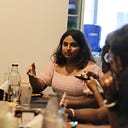How I Transformed Daily Health Tracking for 10k+ Users — From Chronic Patients to Busy Professionals.
Credo Health is a healthcare app that gets meals, vitals & activity loggings from users & helps them with care plans for their wellness & chronic conditions.
Healthcare sector | 6 months timeline | Mobile app designing | B2B & B2C
My role as a Sr. Product designer (& founding) involved mentoring the team, cross-team collaborations, research & design.
A little history of the product
The company had around 100 users, who gave their data through WhatsApp & phone calls, to health coaches, who entered into the web app. There was a mobile app designed & developed by the developers, SMEs & product managers. But it was used by less than 10% of the users. This is where I landed in the company.
👴🏻 👨🏻 Designing for 30–80 years of age
The users were from 2 different areas. One type included chronic disease patients referred from hospitals (B2C), they used the medical care app. Second were employees from corporates, they used the wellness app (B2B).
This is what I changed
We had many disenrollments in our company. We discovered these as the main problems;
- Long logging flows of meals, vitals, etc.
- Overloaded data & no constructive feedback
- App crashes & loading issues
- Lack of motivation & disengaging experience.
and this is the process that I followed to build this product…
I used the app as a daily routine over a brief period of 30 days and tried to empathize with the users. The app lacked sync of all kinds of smart devices, so it was difficult to log vitals.
I also found out that meal logging was difficult, due to the large amount of data needed & limited database of recipes.
I also found out that I was offered a large number of values as insights, but that didn’t help me to know what I should do to maintain my health.
To confirm if others had the same issues,
I formed a cohort with 50+ users from different personas and conducted the research.
Quantitative analysis
The daily average users, OS users, age category, session per day & average time/session were found, to know the logging pattern of members. The average clicks to complete a full day’s log is also calculated.
Qualitative analysis
Users stated that the app is unwelcoming & so much task-oriented only. The app has been crashing repeatedly, many unwanted data are shown & needed insights are less, clinical terms are unclear, the meal database lacks items & the flow is too long, & app is not motivating enough.
Bounce points & feature adoption
The most used features were the logging of steps, water, meds, and vitals. Unused were the trends, adherence, and meal log. The others were not used & the reasons were
- Loading time is low but frequent
- Trends — Too much data
- Adherence — No insights
- Meal log — Too long & lack of DB
We crafted a user persona, with 4 care programs. Every program has a unique need in the app. Diabetes patients want glucose & blood sugar as their primary entry. Likewise, weight management has weight & glucose, cardiac patients have a pulse, heart rate & BP, and kidney disease patients have water as their primary intake.
So, these were the problems identified from user interviews & surveys, & how we synthesized them into actionable insights, & formed solutions.
Here comes the last part, the designs
We went on with a few sample screens directly since we had less time, and did a bit of A/B testing to decide the design language. Then we created the screens for every flow. Going forward, you will look at the past & present versions of the screens.
Onboarding
The screens had more typable fields, less clickable area & a clumsy UI. Instead, I changed it to a screen with initially 3 main value propositions, a white space & more clickable screen.
Home screen
Logging screen
All vital logs & device syncing flows were made in under 3–4 clicks (ignoring repetitive logging) & the interface was made clearer.
Meal logging
The meal log, the most complained flow was revamped with clear UI, easier navigation & a better database. We introduced food image recognition & voice recognition. Our base inspiration for manual food logging was Zepto & Swiggy to add quantity. The number of clicks reduced to 4 from 10. These were the journey maps.
For the usability testing part, I asked the following questions:
With more iterations & production release, as a result of this revamp,
